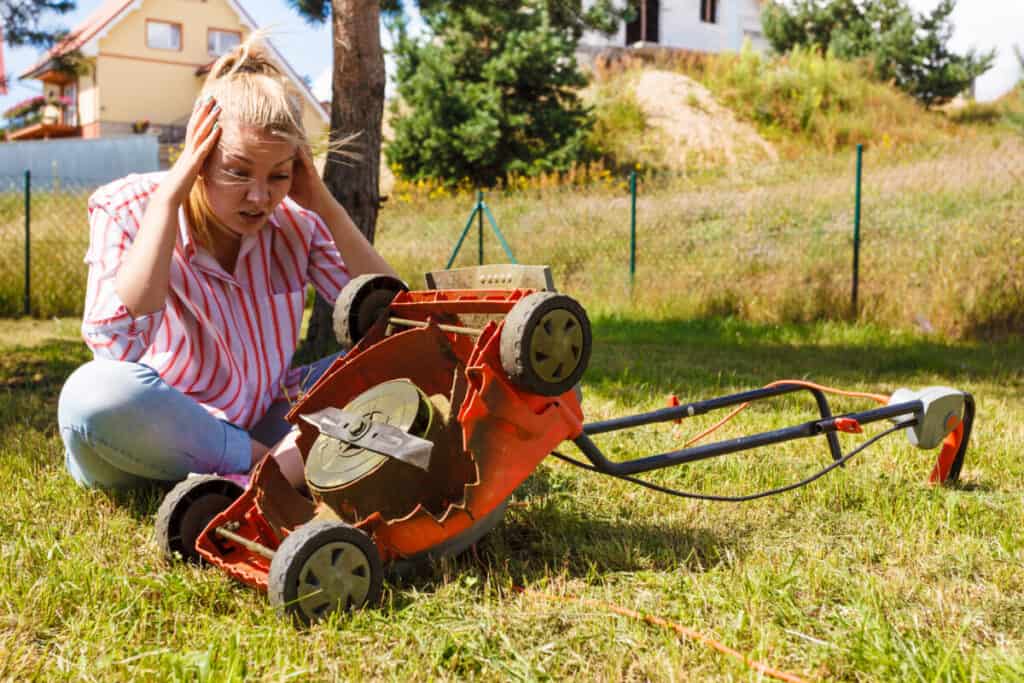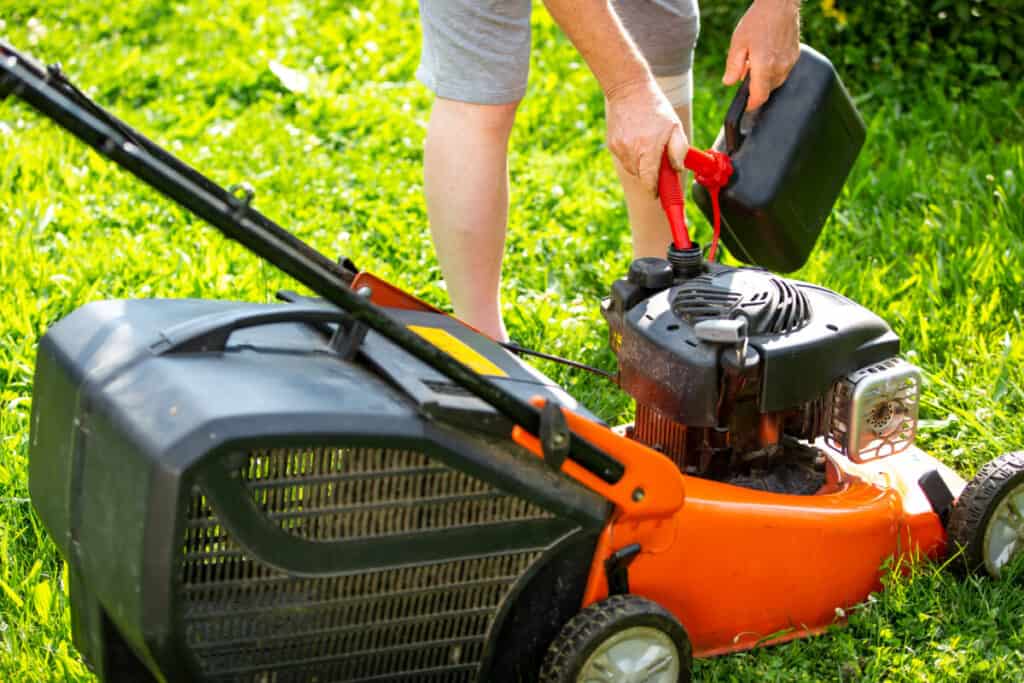It would probably be difficult to name even one person you know who does not own a lawnmower. These machines are useful for cutting grass and keeping your lawn nice, and, in the instance with riding lawn mowers, they can even pick up leaves, twigs, and make mulch for your flowerbeds. It seems like lawnmowers could handle just about anything, but the real question is, is rain/water one of those things?
Lawnmowers technically can be left out in the rain, though it shouldn’t become a regular habit. As long as they are left out in the rain without getting soaked, it should be fine. However, if moisture were to make its way into the spark plug or air filter, the mower could suffer some serious damage.
Lawnmowers were built to withstand the conditions of the great outdoors which means a little rain or hose water now and then won’t do a whole lot of damage. However, you shouldn’t make a practice of leaving your mower out in the rain because repeated exposure will eventually allow moisture to leak into sensitive areas and that will lead to the mower being completely ruined. If you need to know how to fix a mower that’s gotten too wet, you have come to the right place!
What Will Water Do to a Lawnmower?
As mentioned earlier, lawnmowers are sturdy machines. They were, after all, designed to withstand grass, sticks, dirt, and other things that nature has to offer. Your mower is bound to get wet at some point in time, whether that is thanks to rain, sprinklers, or simply being left out overnight and the morning dew gets to it. As long as it hasn’t gotten thoroughly soaked or submerged, there’s usually not anything you need to worry about. However, constant exposure to moisture could wreak havoc on your mower and you need to watch for the warning signs.
If the lawnmower’s exterior is the thing that has gotten wet, there’s no problem. However, as mentioned before, there are places such as the spark plug, carburetor, air filter, gas tank, and similar parts that should not be touched by moisture. If you have found that your mower won’t start after being left out in the rain or the sprinklers, that probably means that water has either gotten into the carburetor or has damaged the spark plug.
You may also notice a couple of other things wrong with the mower if water has gotten to the system. Of course, it may be something other than water, but if you know it was exposed to water in the recent past, it’s a more than likely cause. You may notice that your mower will start to give off a mildewy or moldy scent and that is how you’ll know that water has gotten to it.
The real indicator that water has damaged a mower is the obvious sign of it not turning on, and that is when an inspection is probably in order. You can either take it to a shop or fix it yourself, depending on how knowledgeable and confident you are.
You may also notice other things, such as a lack of acceleration and/or power in general. If your mower abruptly starts and stops every time you try to use it, this could also be a sign that moisture could be messing with the system.

How Do I Fix my Lawnmower When It Got Wet?
Getting rid of moisture in your lawnmower is a pretty easy undertaking most of the time. If you need to dry out a damp lawnmower, the first order of business is to simply turn it on. Lawnmowers generate quite a bit of heat once the engine starts to run. This self-generated heat will usually be enough to dry out all the moisture inside a mower’s system.
If you let it run for a little while and that should be the end of your problem. You should probably make a habit of turning it on whenever it has gotten wet because that will almost immediately remove any moisture. Doing this will also prevent rusting from occurring both outside and inside the mower.
That’s all well and good but you are undoubtedly wondering what happens when the lawnmower won’t start at all? This is when you’ll have to dig into the inner workings of the lawnmower which won’t be fun, but it might be necessary if you want your mower to run ever again. Sometimes it’s a lost cause, but this is not always the case!
The first thing you ought to do is check the fuel and oil tanks. Probably the worst thing that could happen is getting water inside the carburetor and/or gas tank. Empty the gas from your mower into a clean container. Water and gasoline mix the same way oil and water mix, so if you see small bubbles floating around in the gas, you will know that water has made its way in there and that will need to be fixed.
If this ends up happening, you will have to essentially take the entire mower apart and thoroughly clean each of the parts. Then, once they have been left out to dry for long enough (make sure absolutely no moisture remains!), you will have to put it back together again.
This is a pretty long and tedious process, so be sure that you’re up for it before getting started. You need to know that this is going to be a big job if your lawnmower has reached the point where it can’t start up. If you are a handyman, then this will probably be no sweat. However, if you don’t feel like you can or want to undertake that task, you can also take your mower to a friend or a repair shop.
If the carburetor/gas tank is not the problem, your next step should be to inspect the spark plug. Take it out and thoroughly clean it and then make sure it gets thoroughly dried. After you have done that, replace the spark plug and try to start the lawnmower up again.
If the mower still won’t start, your next item of business will be to remove and clean the air filter. If we’re being honest, this should be a habit you develop whether or not your mower has gotten wet. If the air filter becomes too clogged with dirt and grime, it could contaminate your fluids which will also cause the mower to stop working. It’s a good idea to clean this regularly regardless of the circumstances.
As with the carburetor and/or gas tank, you will need to remove the air filter and clean it thoroughly before putting it back. If necessary, you may need to completely replace the air filter (usually if it’s majorly clogged or filthy). If you clean it and find that your lawnmower is still not starting up, it might be time to give up and visit a technician/repairman.

Can I Mow If the Grass is Wet?
Technically you can mow wet grass, but it is highly discouraged for the same reasons that leaving a mower in the rain is discouraged. While it is possible, you will likely start to suffer a few issues with your mower at the end of the day. For one thing, wet grass is much harder to cut, and cutting it can dull your mower’s blades.
If you mow with wet grass often enough, you may find that it will clump together and start to clog up the blades and interior of your mower. This will put a lot of unnecessary and unhealthy strain on the motor and if you don’t watch out you could very well find yourself with a smoking, damaged motor that refuses to work any longer. So, long story short, you should probably avoid mowing the grass when it’s wet.
Lawn Mower Maintenance
As mentioned earlier, water/moisture is not the only problem that your lawnmower could potentially be facing. If you want to prevent yourself from having to pay for costly repairs, you should do as instructed and take care of your mower when it has gotten wet. There are also a few maintenance tips that could prove to be invaluable in the long run. Here are a few of them now!
First of all, you should take great care when you mow your lawn. As mentioned before, do not mow the grass when it’s wet because you risk clogging your mower blades and causing undue stress on your mower. Let the sun come up for a bit and then mow. You should also thoroughly inspect the yard before mowing as well. Get any large sticks, rocks, and other debris on your lawn out of the way.
The last thing you need is to suck up a rock and have your mower quit on you. If you’d like to, you can even check your mower into a repair shop for professional maintenance and repair. This could get expensive if you do it too often, but annual checkups are one of the best ways to keep your machine alive and kicking!
As for your own maintenance regime, you can undertake it at pretty much any time of the year that you want. However, spring and summer are the recommended seasons for obvious reasons. That’s when everybody is looking after their lawn and pulling out their tools. This will be far easier than taking care of a lawnmower during the fall or winter!
The very first thing you should do is check and change your mower’s oil (I’ve written an in depth article about what oil to use in your Lawn mower here). Just as you would take your car in for its annual oil changes, the lawnmower needs them desperately as well (you will want to change it after every few uses or so). Check the oil to see if there is any debris or discoloration. If there are either of these things, you must change the oil.
Remove the spark plug and allow the oil to drain into a container (which you will need to safely dispose of). Once the oil has drained, fill the tank back up. Make sure you don’t slack on this. Contaminated oil is one of the worst things you can let your mower sit with because it can be pretty damaging.

You will also want to keep a close eye on your fuel as well. Using a lawnmower that’s running on stale fuel won’t do you any favors so get that checked often as well. If necessary, you can also use a fuel stabilizer or some other form of treatment that will keep your oil fresh for as long as possible.
As mentioned earlier, the maintenance season usually starts in spring and continues throughout the summer. When fall rolls around and it’s no longer necessary (or possible) to mow your lawn thanks to the cold, that’s when you should empty your mower. Leaving gasoline in the mower for the entire winter will potentially cause your fuel to go stale.
It will also pose the risk of freezing. This only happens at very low temperatures though, gasoline freezes at around -40F. So if you’re living in rural Siberia, you should be careful. As you undoubtedly know, liquids expand when they freeze, so if your gasoline freezes inside the tank, it could rupture your tank and cause some serious damage that might result in you having to get your mower replaced completely. Empty your fuel tank as needed if you want to avoid this situation!
As mentioned before, you might also wind up needing to replace the air filter. Mowing is a filthy undertaking, so you’d be surprised at how little time it takes for the air filter to become clogged and filthy dirty. This air filter will help your mower function at optimal performance so see that you change it out as often as needed. This will keep your mower working and working well.
Additionally, you should clean and remove the spark plug as often as needed. As mentioned above, if the spark plug gets wet, it will require replacing or at the very least a drying out. Clean it often if you want to keep your mower functioning the way it’s supposed to. It is also advised that you remove the spark plug before undertaking any kind of maintenance. This is mostly a safety precaution; removing the spark plug means there will be no accidental startups while you are working on your mower.

